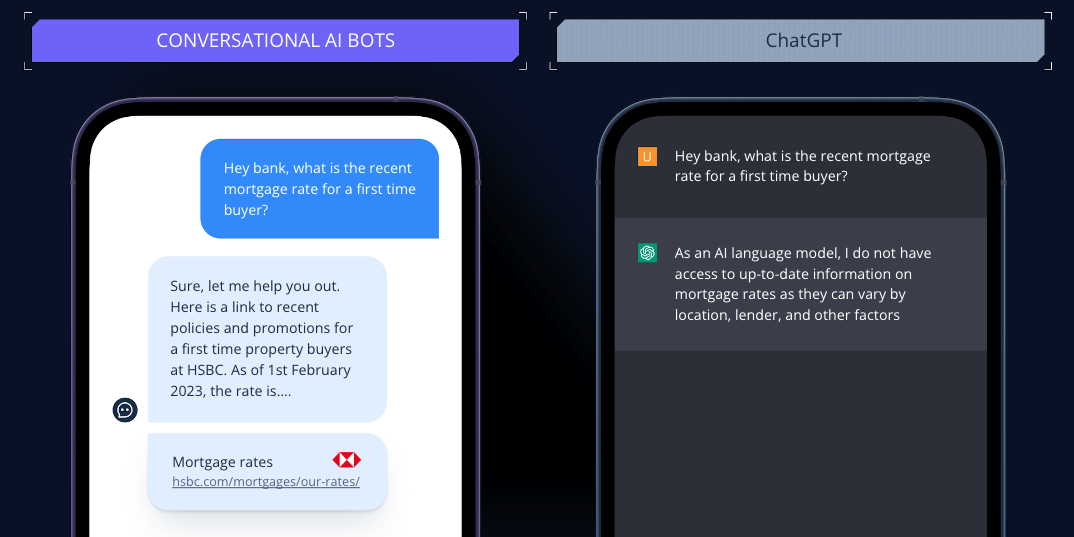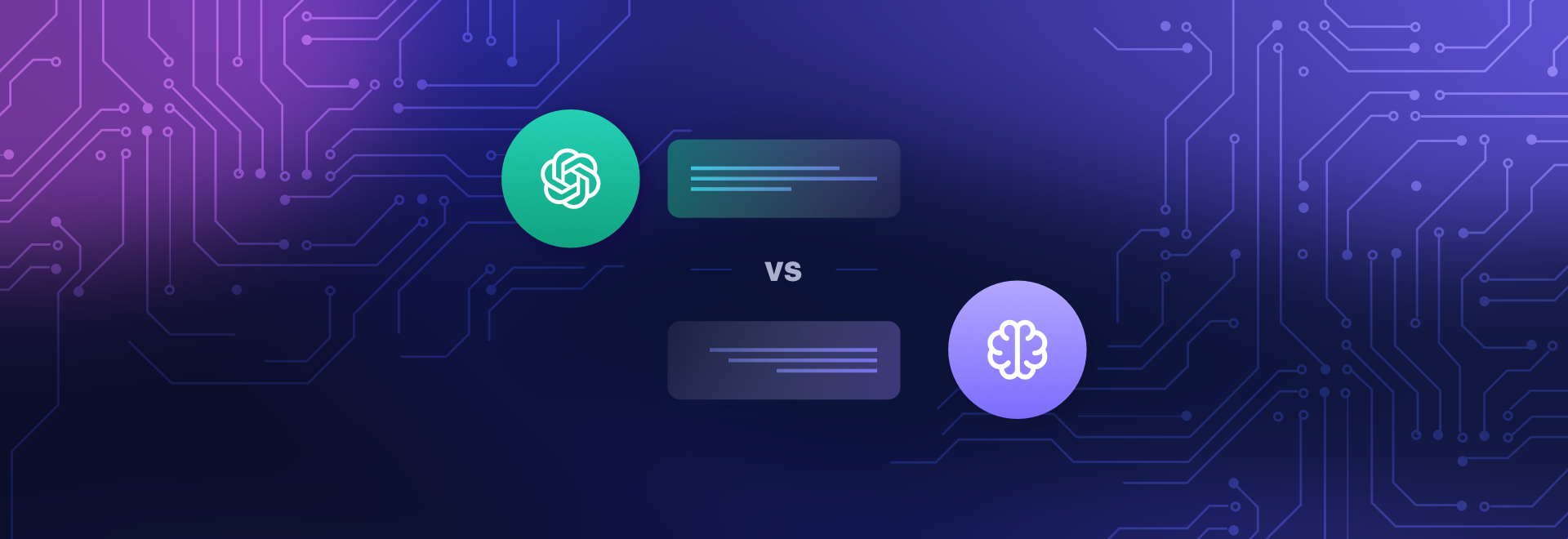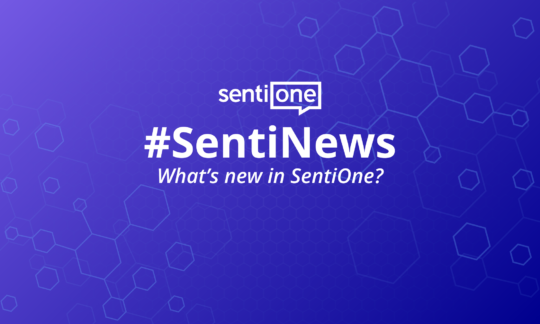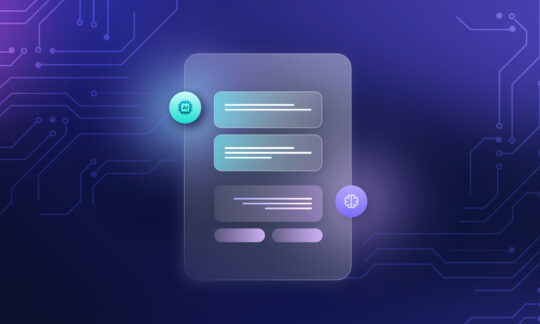Customer Support: Will ChatGPT Replace Conversational AI Bots?
Table of contents
- Conversational AI vs Generative AI: Demystifying Products in the AI Chatbot Landscape
- The Allure of ChatGPT for Customer Service
- Conversational AI’s Customer Service Features
- The Bottom Line
- Take Advantage of Conversational AI
- Article Summary
For centuries humans believed in magic – only in the past couple hundred years they found new amazement through more rational pursuits in science and technology. Somehow, somewhere, the two became intertwined. Today, some speak of the future capabilities of AI as our ancestors whispered of the powers of spirits. It’s tempting to get swept up in the hype of artificial intelligence having the all-seeing knowledge of the ancient Greek oracles. But if you are a business leader with the challenging responsibility to choose the right technology for your company, it’s your duty to sort fact from fiction, as your budget is bound by reality. However, with the right strategy and plan you can be the one who bought the magic beans that grew into a beanstalk nestling a golden goose.
So, let’s pause on mythology and focus on a business challenge: choosing the right AI solution for customer support. To succeed, you must:
- Understand the business challenge and opportunity
- Assess the solutions available, sometimes making an educated gamble in a rapidly shifting technological landscape
- Develop a bullet-proof business case with exceptional ROI
All this while the influence of the media, society, your peers, and your corporate leaders are swept up by shiny new disruptions like ChatGPT.
Let’s dissipate the fog a little, and take a clear look at what ChatGPT is, and what it isn’t. Let’s zoom in on the capabilities you need for a best-in-class chatbot to provide customer support for your business. We’ll also explore the pros and cons of the solutions available today, including ChatGPT.
Conversational AI vs Generative AI: Demystifying Products in the AI Chatbot Landscape
For the business tasked with supporting customers through AI chat, it’s important to understand the distinction between two types of AI applications: conversational AI, and generative AI.
Generative AI systems are designed to create. The output can include images, videos, text, and much more. ChatGPT is a generative AI system that uses a large language model (LLM) to respond to questions using natural language that humans can understand. It acquires the data for its responses through training using massive amounts of text data. As data is processed the system develops associations between words, an AI-based neural network. This massive dataset of information enables ChatGPT to offer pretty sensible answers to virtually anything you might ask. When you provide a prompt, ChatGPT reads, summarises, and translates text by predicting appropriate future words in a sentence. ChatGPT selects and sequences words to your original prompt using associations from its neural network. It does not have the faculties to understand the meaning of the words provided – that’s up to the reader. Nonetheless, the accuracy and relevancy of the answers provided can at times be astonishing.
Conversational AI is a type of artificial intelligence (AI) that can simulate human conversation. It is made possible by natural language processing (NLP), a field of AI that allows computers to understand and process human language. NLP is used to analyse the meaning of text and speech, and to generate responses that are appropriate and relevant to the conversation.
Conversational AI bots are designed in a way to be useful and effective for businesses deploying them: they can connect via API to various communication channels, as well as to company’s CRM, internal tools and database. Thanks to that, they are suitable for business use cases: customer service, sales and internal processes. Conversational AI bots work in a system of tools, systems and infrastructure, while ChatGPT are stand-alone bots that just create beautiful responses.
Among all these components you will find a language model that is designed to generate human-like responses to customers. When we compare ChatGPT to conversational AI, it’s this natural language processing (NLP) component that we’re squaring off. ChatGPT is a state-of-the-art solution for generating responses in natural language. But if you extend this comparison to an actual customer support scenario, it’s all those other components of conversational AI platforms that are critical to consider.
| AI Bot (SentiOne) | ChatGPT | ||
|---|---|---|---|
| PROS | CONS | PROS | CONS |
| Safe and reliable for business – will always answer the same way, keep the same quality | Better for business use than an open to public, “ask me anything” type of bot | Useful to speed up content creation for marketing or sales teams | Limited business use case – can’t integrate with CRM, databases or internal tools |
| Easy to integrate with internal tools, CRMs, teams and architecture | Requires a bit of setup, bot design, defining processes, intents and phrases | Can support the building process of bots e.g. phrase & response creation | Extremely expensive |
| Deployed on cloud or on-premise | Less “creative” than ChatGPT | Access and capacity is not yet guaranteed | |
| Can be trained on business-specific training data to be more accurate and helpful | “Black box” bot – doesn’t understand questions and answers | ||
| Offers no control over data storage and security | |||
The Allure of ChatGPT for Customer Service
The widespread popularity of ChatGPT may have some business leaders wondering if generative AI models like the one used by ChatGPT could be used to respond to customer inquiries for their business. With ChatGPT specifically, it is built, trained, and available to integrate into a chat interface (e.g. a company website) through APIs. It can quickly provide a logical and well-articulated response to any type of inquiry. It processes, translates, and summarises text impressively. Looking forward, we can expect future updates to improve ChatGPT’s capabilities.
To fully assess ChatGPT’s potential for customer service, it’s important to draw parallels with the full range of capabilities in the conversational AI chatbots available today.
Conversational AI’s Customer Service Features
Let’s look at these in two categories: quality of interaction, and keeping customer information secure.
Quality of Interaction
Your Net Promoter Score and customer satisfaction scores are enormously dependent on your company’s ability to quickly and efficiently resolve customer issues. When using an AI chatbot as a component of your customer service, there are several factors required for a high-quality customer experience, including:
Recognising a Customer (or Entity)
Conversational AI has capabilities that can securely identify and authenticate a customer. When integrated with business back-end systems, this opens the gateway to personalised service that gets to the root cause of that specific customer’s issue.
Generative AI systems like ChatGPT do not have the capabilities to identify a distinct user. While the beauty of ChatGPT is that you can get a sensible answer to 1 million questions, the reality is that you will never get an answer that’s truly personalised based on who you are and your situation.
Understanding the Context of a Conversation
Conversational AI assistants are powered by NLU, which allow the chatbot to process prior responses and associate probable answers. This enables multi-step conversations which, if you’ve ever tried to sort out a billing issue with a company, is critical to customer-focused problem-solving.
While the vast range of answers provided by ChatGPT creates an illusion of an omnipotent intelligence, the reality is that ChatGPT is unable to interpret the true meaning of the words it produces. It follows a pattern of associating the most likely next word in a sentence to formulate the response to a query.
Performing Service-Related Actions
Generative AI systems like ChatGPT are not designed to integrate with business systems such as e-commerce and CRM. Conversational AI chatbots are designed for a wide range of business integrations, allowing them to respond to customers by listening, interpreting, and then taking action to resolve an issue. A chatbot can initiate client transactions such as:
- Placing and processing orders
- Collecting payments
- Providing account details
- Scheduling
- Reporting issues or complaints.
The chatbot artificial intelligence has more opportunities for deep learning when enabled with the processes and tools for end-to-end resolution of customer problems. It can continue to identify what actions are most effective and continually optimise responses.
Data Recency
Because conversational AI tools can connect into business systems to collect information, they can be trained to retrieve the most recent information from a knowledge centre, such as product information and pricing. In contrast, generative systems such as ChatGPT are limited to the most recent source material it has received, and cannot conduct calls to retrieve new information.
Pre-trained Language Model
When it comes to having answers at the ready, ChatGPT is unparalleled. ChatGPT is exceptional for the wide range of information it can access, but only for information publicly available on the internet.
Conversational AI does not come with the depth of information available from ChatGPT. But it does raise the question, do you need your accounting firm to be able to describe to customers the history of the Ottoman empire? With conversational AI, the emphasis is on training for the specific needs of your business, usually starting with the most common customer issues first. That is why conversational AI bots are suitable for business settings, as they can be trained on industry specific language models.
Access to Business Knowledge, Product Feed, Pricelist
Conversational AI can be trained using company datasets, such as call centre transcripts, to speak accurately and on-brand for your company. These chatbots can provide personalised support to customers based on their unique account details. What is more, conversational AI chatbots can access any internal Knowledge Base – such as product feed, regulations, policy and CRM base. As a result, they can accurately answer even the most detailed customer service queries – for example, offer specific information about the current mortgage rates at a given bank.

Interacting with a conversational chatbot vs a generative AI.
ChatGPT doesn’t have any internal-only information about your company. Think of how much training a typical client service rep receives. A good part of this is internal policy, brand guidelines, complaint escalation routines, etc.
Risk of Incorrect Responses
Conversational AI allows business owners to carefully control response routines, particularly for the most common customer issues. One of the hallmarks of conversational AI chatbots is consistency.
ChatGPT creates text from a large dataset but has no real understanding of meaning. It sometimes causes AI to hallucinate and give answers that are inappropriate, outdated, or just plain wrong. Business owners have no control over how ChatGPT responds.
Keeping Customer Information Safe and Secure
Is the security of personal information your customers share with you an important consideration for your business? It’s hard to imagine a scenario where it isn’t. Data privacy, security, and confidentiality are areas where the difference between generative AI and conversational AI platforms may introduce some showstoppers for business use.
Data Privacy and Security
Conversational AI platforms deliver virtual assistants and chatbots that prioritise security and privacy, which is especially important in highly-regulated industries. Because these systems are designed to collect client information, authenticate identity, and connect to client information systems, they have checks and balances for the appropriate handling of client data.
For the scenario of integrating ChatGPT into your business website to support your customers, the terms of use and privacy policy of ChatGPT’s parent company, OpenAI, may not address the requirements of many Compliance and Legal teams.
Data Storage and Retention
Most companies must have a clear and transparent data retention policy, as well as audit-ready procedures to verify that data is stored and handled in a compliant way. Conversational AI virtual assistants provide capabilities and options to support a variety of data management policies.
Setting up a customer service chatbot with a cloud-based service like ChatGPT would likely involve some compromises in your data management policy.
Data Sharing with 3rd Parties
Conversational AI platforms are customised for the unique chatbot needs of a business, providing business owners with full transparency of how data is transmitted and shared. Some companies opt for an on-premises installation to reduce the amount of customer information shared with 3rd party, cloud-based partners.
The processing power required for a ChatGPT-modelled AI system hosted in your on-premises environment would require a huge investment in hardware and infrastructure. Integrating ChatGPT into your business website through APIs would result in your customers’ inquiries being shared with OpenAI.
The Bottom Line
ChatGPT is unable to effectively replace conversational AI chatbots for customer service. When you factor in common business requirements of a corporation, it’s clear it’s an unfair comparison. It’s like comparing an elegant chef’s blade with a Swiss army knife. Both cut, but one has several other functions.
If you were running a company solely in the business of creating conversational AI that would have useful chats with humans on any topic of any kind, ChatGPT just ate your lunch. But providers of conversational AI are doing it in the context of creating a holistic business solution, of which the ability to interpret questions and formulate answers is just one component.
What we can expect is that ChatGPT will shake up the approach to natural language processing, which is a component of conversational AI systems. The quality of ChatGPT’s human-like responses sets a new bar for the quality of chatbot dialogues. It’s not a straight lift-and-shift standalone platform for enabling client-facing chatbots for businesses. Businesses need personalised models, trained in the language of their industry, products, and brand.
ChatGPT is a brilliant natural language example of generative AI. There are many ways it can add value as a business tool, such as multi-language content creation, and speeding up the training process for new chatbots. However, when you look at a specific business use scenario like customer support, it cannot compete against systems custom-built for the wide range of tasks and requirements of modern businesses.
Take Advantage of Conversational AI
Exploring the benefits of an artificial intelligence virtual assistant for your business? SentiOne Automate is a robust conversational AI platform with features that include an intuitive no-code bot builder, advanced NLU capabilities offering 94% intent accuracy recognition, and comprehensive bot analytics. Book a demo for a real-time view of Automate’s features. To assess the potential ROI of an AI assistant for your business case, try our Bot ROI calculator.
Article Summary
The article discusses the differences between conversational AI and generative AI, focusing on ChatGPT as an example of generative AI. While ChatGPT is impressive in generating human-like responses to a wide range of questions, it lacks certain capabilities critical for customer support. Conversational AI, on the other hand, offers features such as personalised service, understanding the context of conversations, integration with business systems, access to up-to-date information, and data security. The article emphasises that when it comes to customer support, businesses should consider conversational AI solutions tailored to their specific needs rather than relying solely on generative AI models like ChatGPT.



